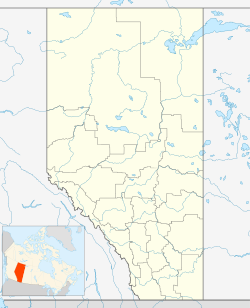Empress, Alberta
| Empress | |
|---|---|
| Village | |
| Village of Empress | |
| Location of Empress in Alberta | |
| Coordinates: 50°57′0″N 110°00′22″W / 50.95000°N 110.00611°WCoordinates: 50°57′0″N 110°00′22″W / 50.95000°N 110.00611°W | |
| Country |
|
| Province |
|
| Region | Central Alberta |
| Census division | 4 |
| Special Area | No. 2 |
| Incorporated | |
| • Village | February 5, 1914 |
| Government | |
| • Mayor | Chad Van Dam |
| • Governing body | Empress Village Council |
| Area (2011) | |
| • Total | 1.75 km2 (0.68 sq mi) |
| Elevation | 615 m (2,018 ft) |
| Population (2011) | |
| • Total | 188 |
| • Density | 107.6/km2 (279/sq mi) |
| Time zone | MST (UTC−7) |
| • Summer (DST) | MDT (UTC−6) |
| Postal code span | T0J 1E0 |
| Highways | Highway 562 |
| Waterways |
Red Deer River South Saskatchewan River |
| Website | Official website |
Empress is a village located along the Alberta/Saskatchewan border; in southern Alberta 121 kilometres (75 mi) north of Medicine Hat. The town was named, in 1913, for Queen Victoria, who was also Empress of India. In the past it was known as the "Hub of the West", connecting major cities together by the Canadian Pacific Railway.
It is located at the confluence of Red Deer River and South Saskatchewan River, at an elevation of 650 metres (2,130 ft). It is connected to Buffalo Trail by Highway 899 and Highway 562.
In the 2011 Census, the Village of Empress had a population of 188 living in 69 of its 73 total dwellings, a 38.2% change from its 2006 population of 136. With a land area of 1.75 km2 (0.68 sq mi), it had a population density of 107.4/km2 (278.2/sq mi) in 2011.
In 2006, Empress had a population of 136 living in 76 dwellings, a 20.5% decrease from 2001. The village had a land area of 1.75 km2 (0.68 sq mi) and a population density of 77.8/km2 (202/sq mi).
Located in the steppe region known as Palliser's Triangle, Empress experiences a semi-arid climate (Köppen climate classification BSk). Winters are long, cold and dry, while summers are short, but with average daytime highs that are warm to hot, though nighttime lows are cool. Spring and autumn are quite short, essentially transition periods between winter and summer. Wide diurnal temperature ranges are regular, due to the aridity and moderately high elevation. Low humidity is prevalent throughout the year. Annual precipitation is very low, with an average of 312mm, and is heavily concentrated in the warmer months. On average, the coldest month is January, with a mean temperature of −12 °C (10 °F), while the warmest is July, with a mean temperature of 20 °C (68 °F). The driest month is February, with an average of 9 millimetres (0.35 in) of precipitation, while the wettest is June, with an average of 69 millimetres (2.7 in).
...
Wikipedia

